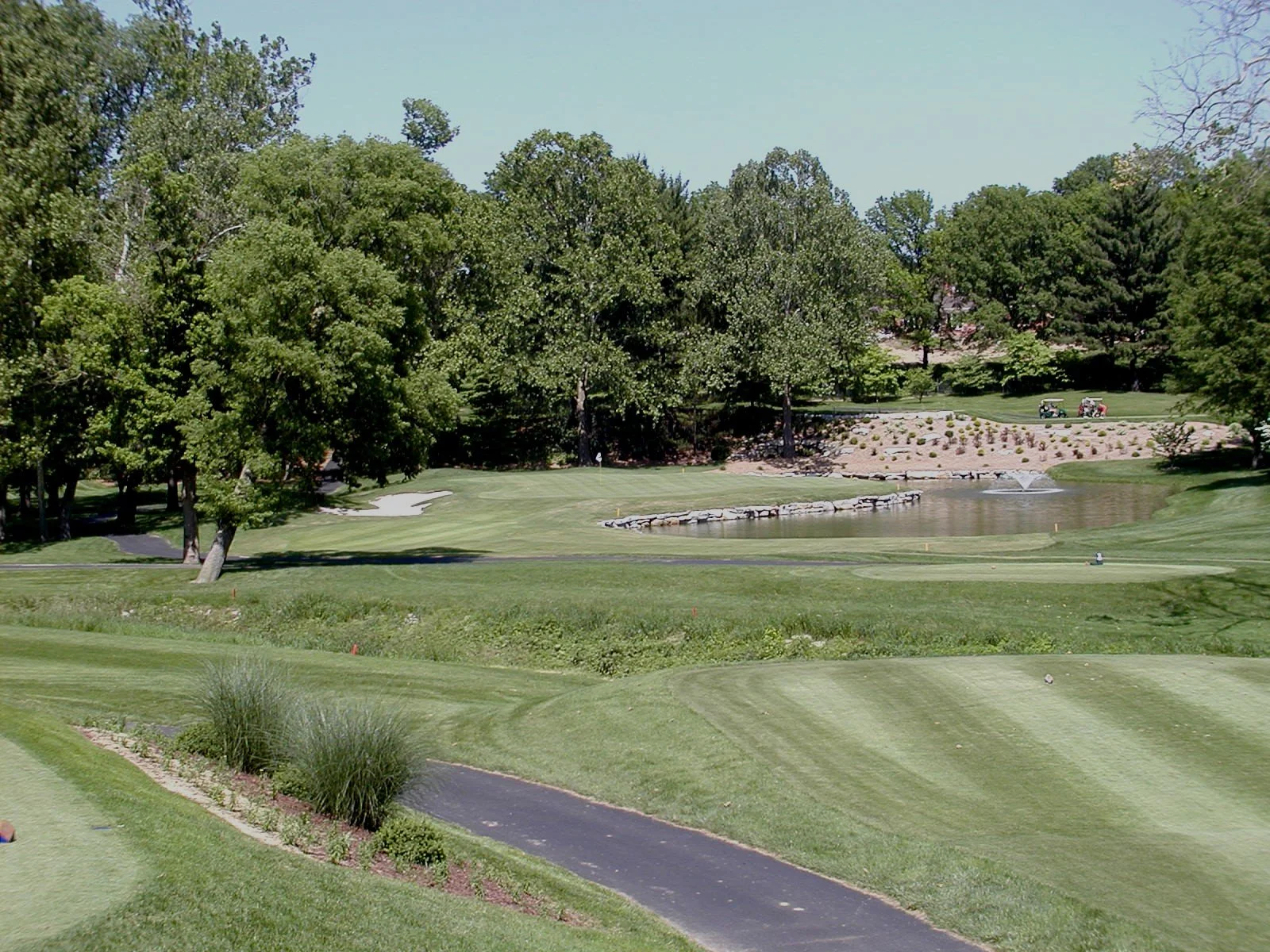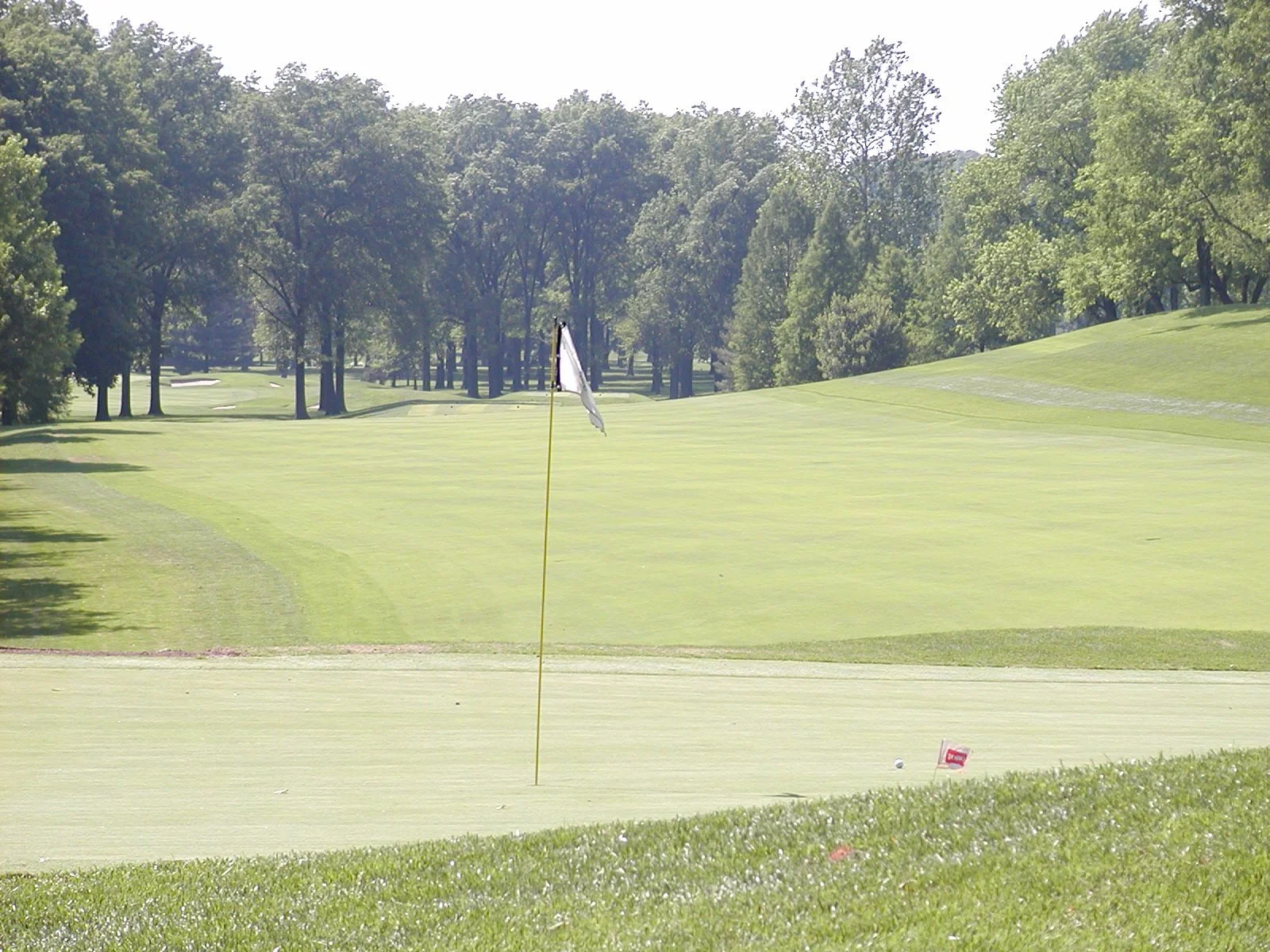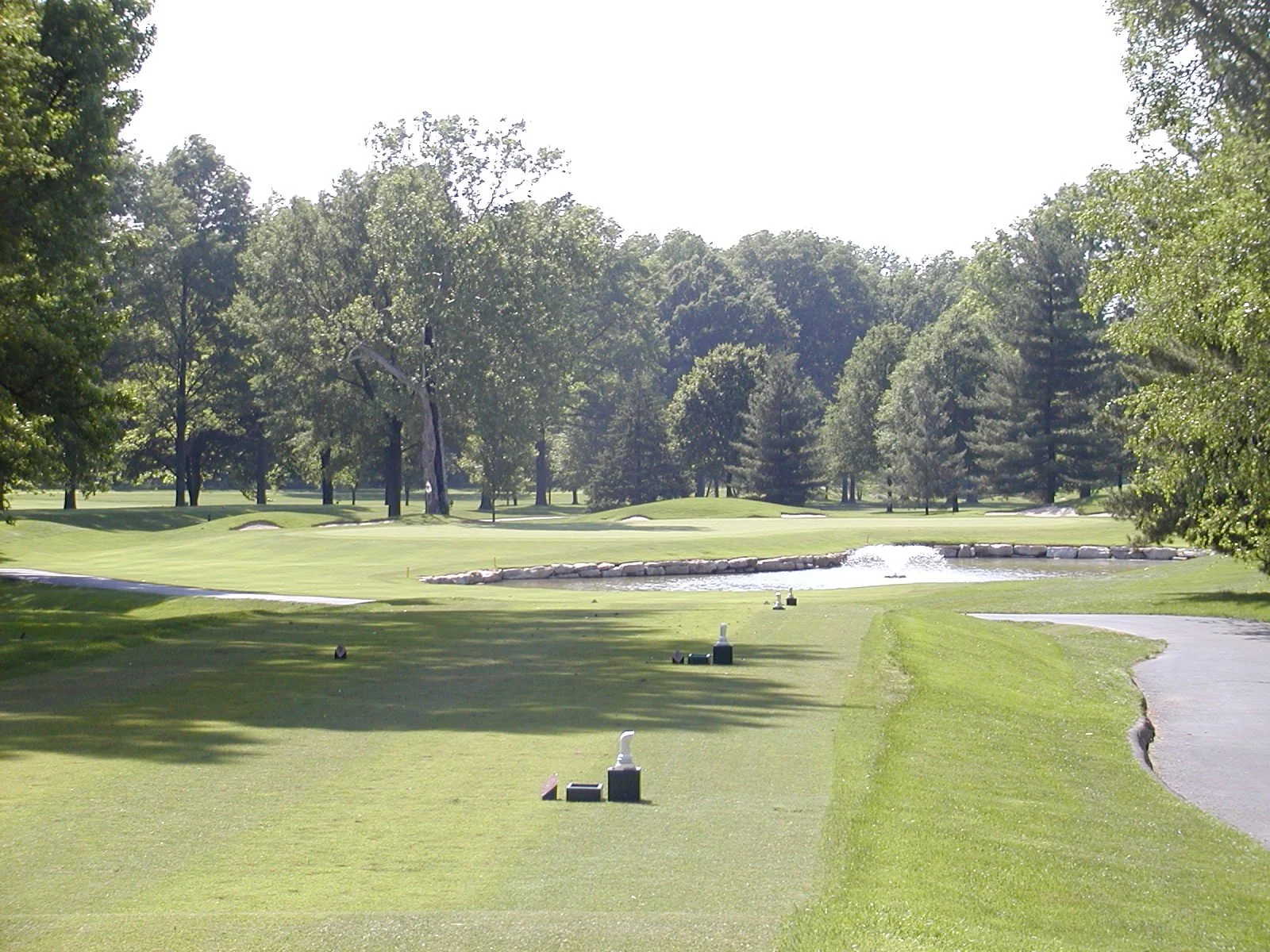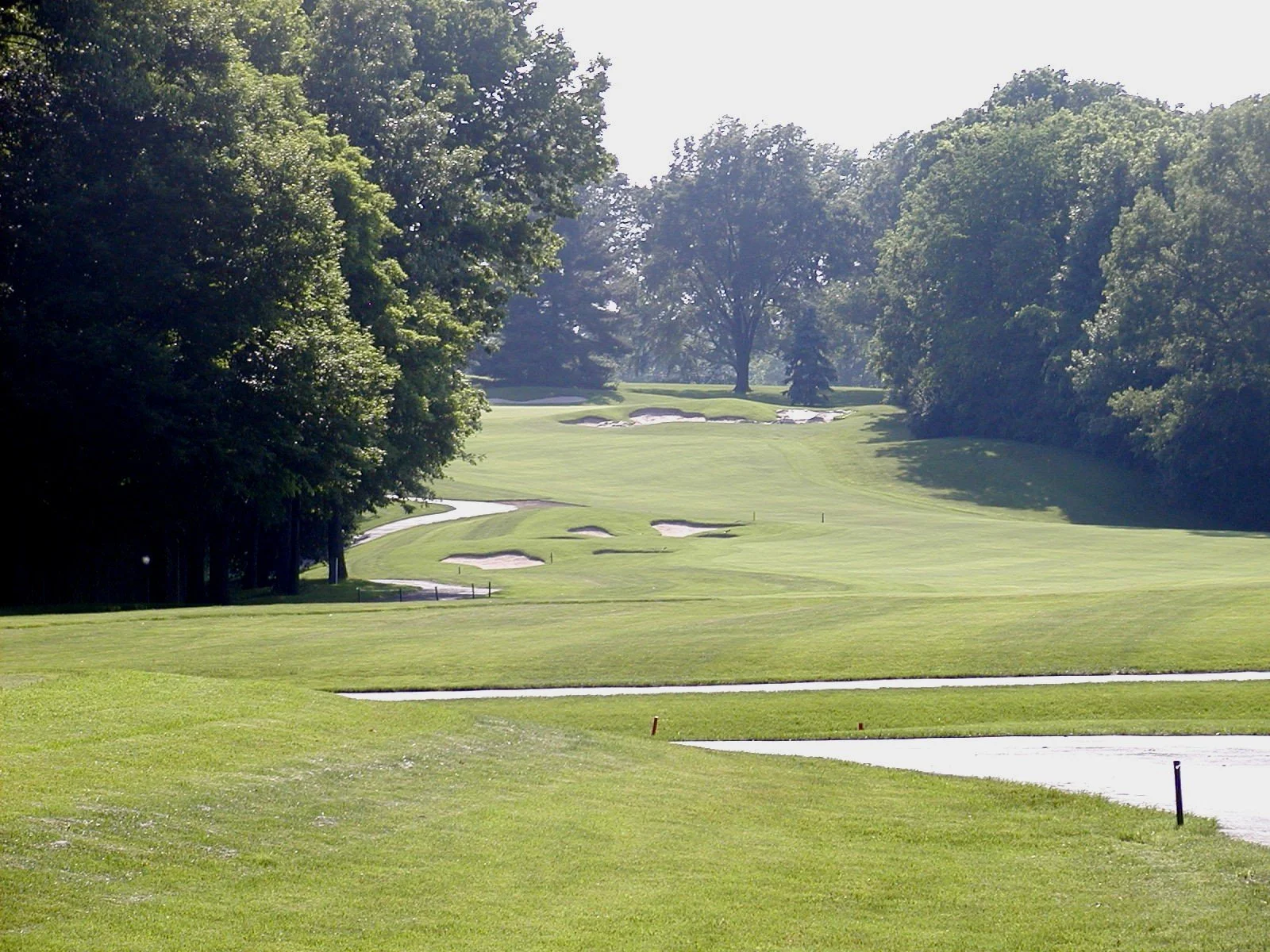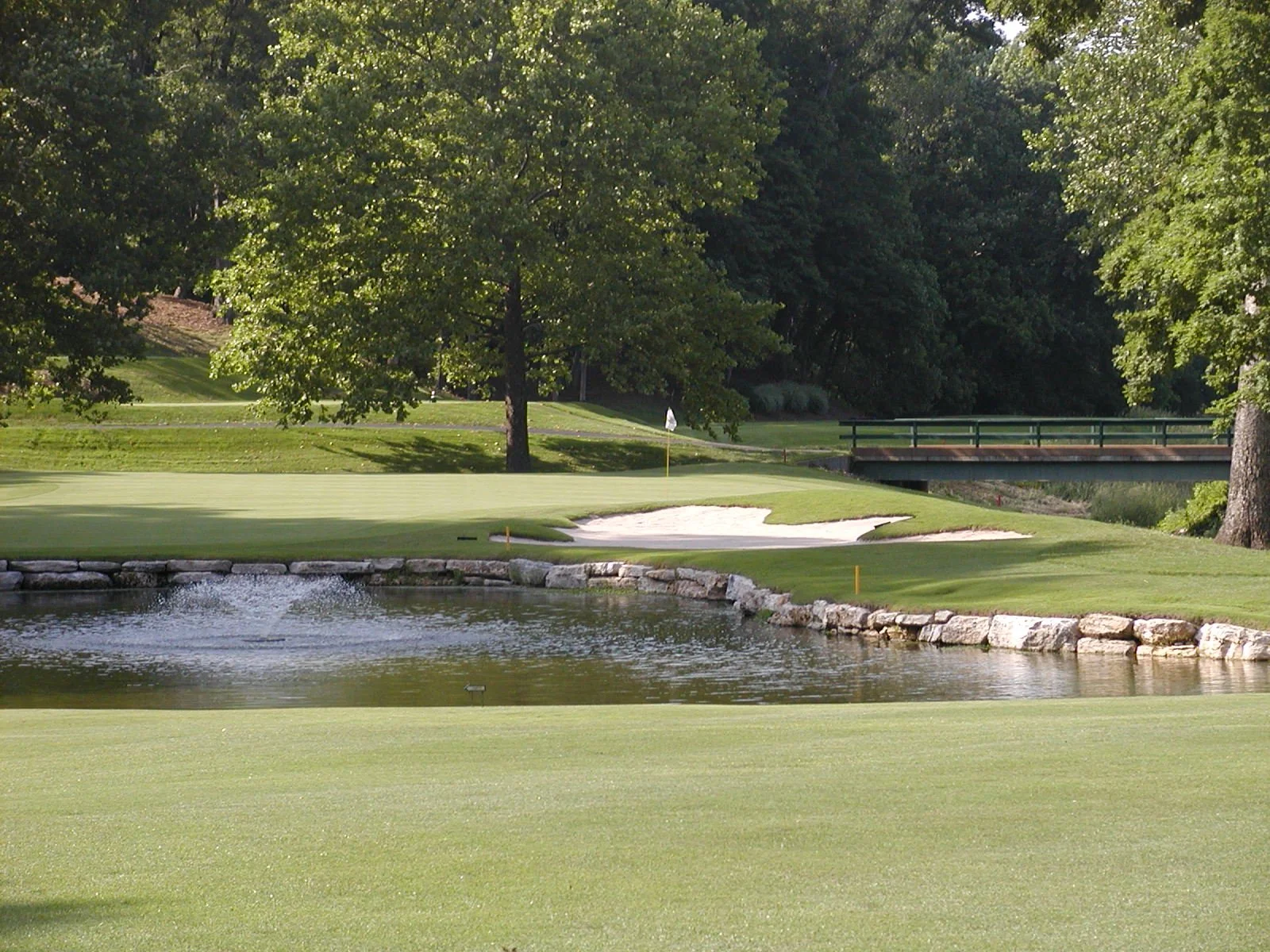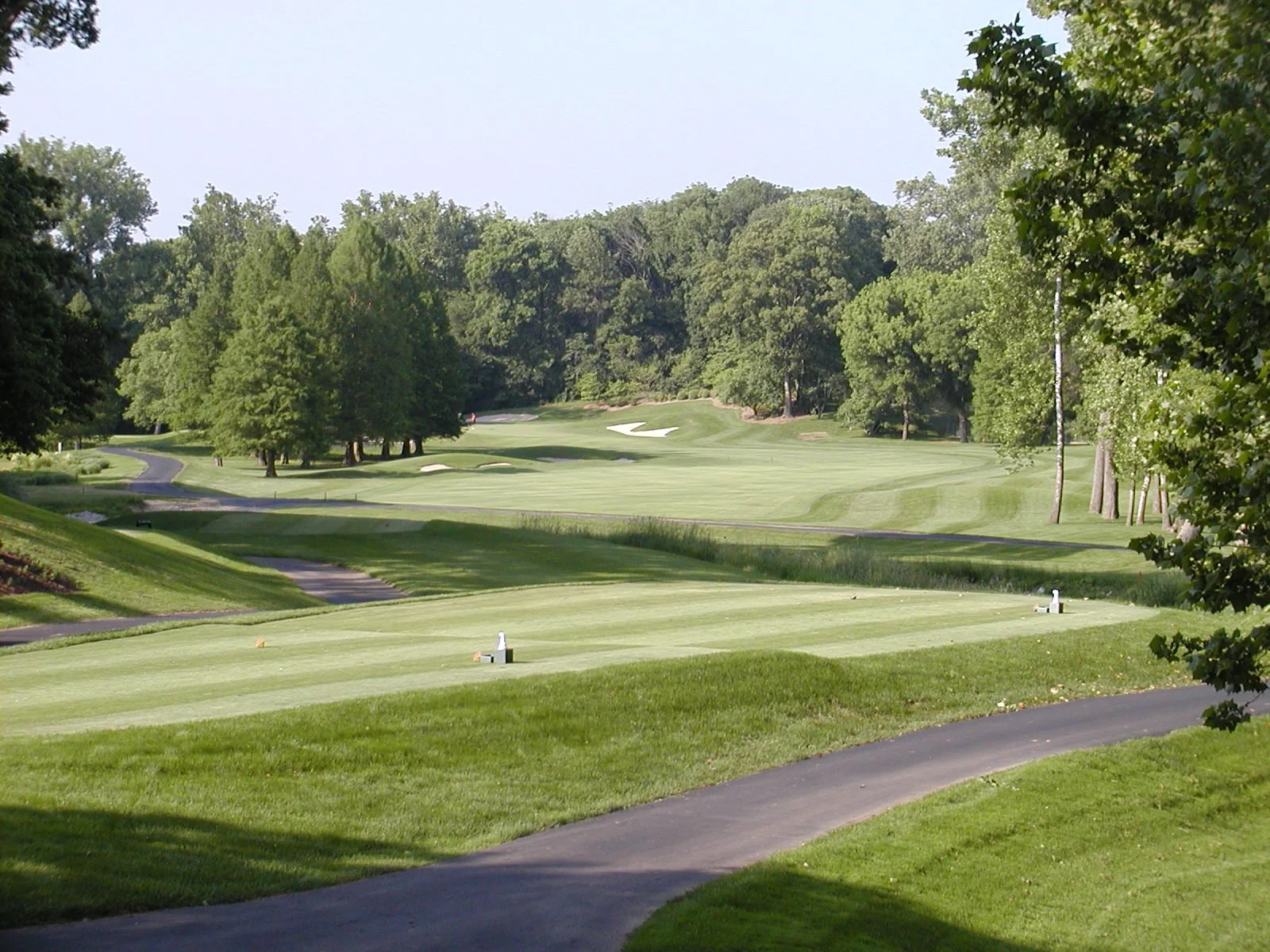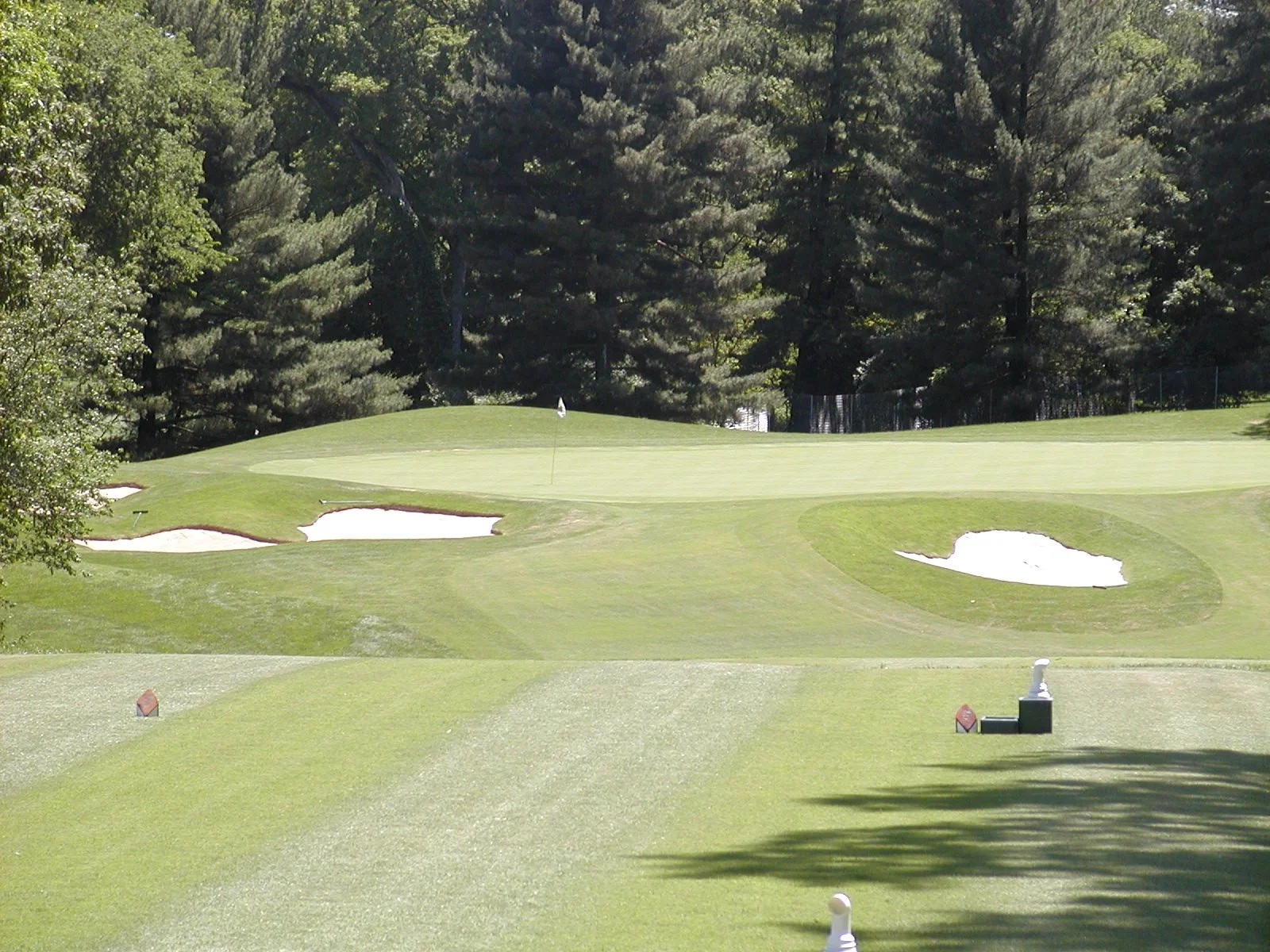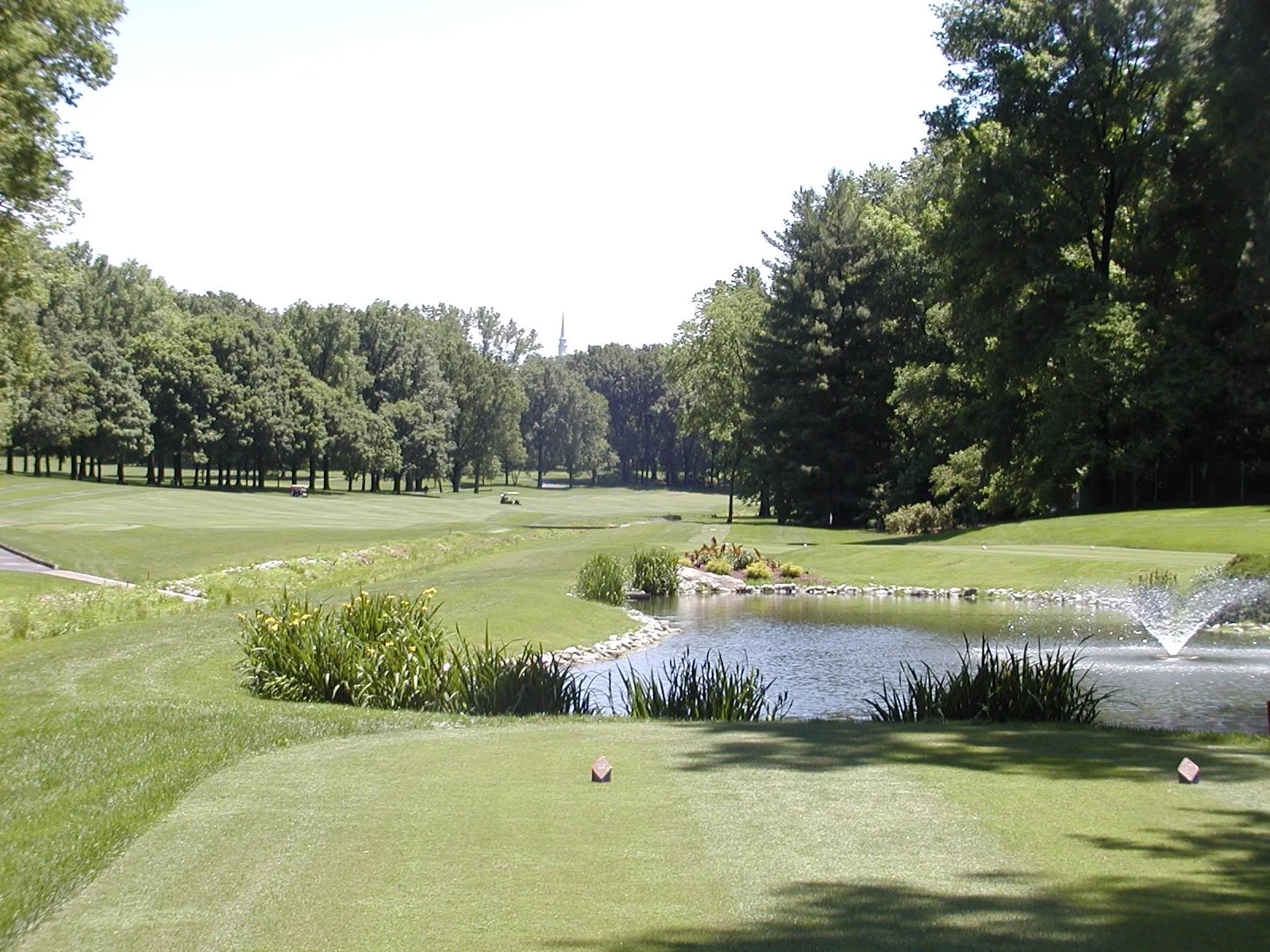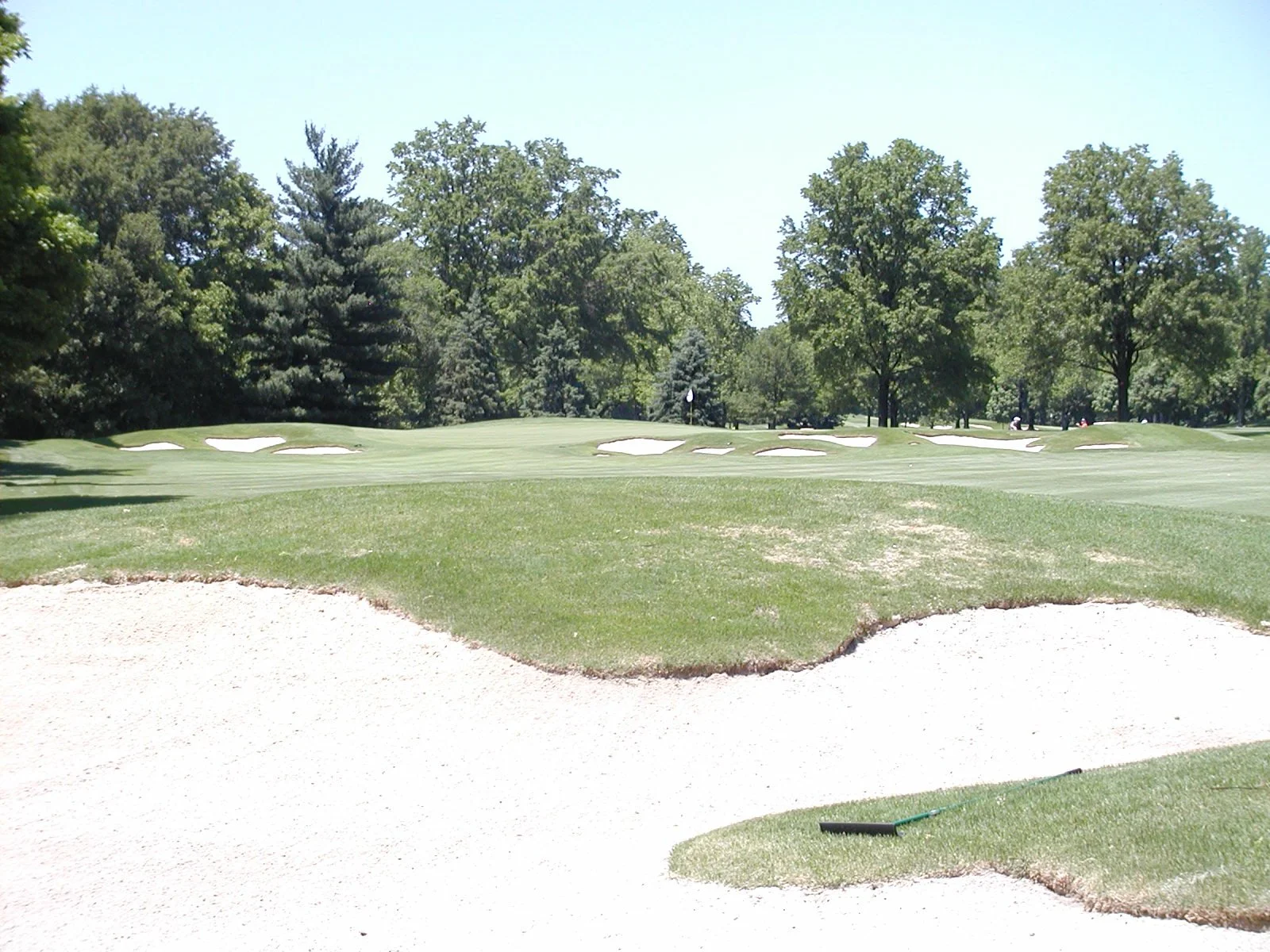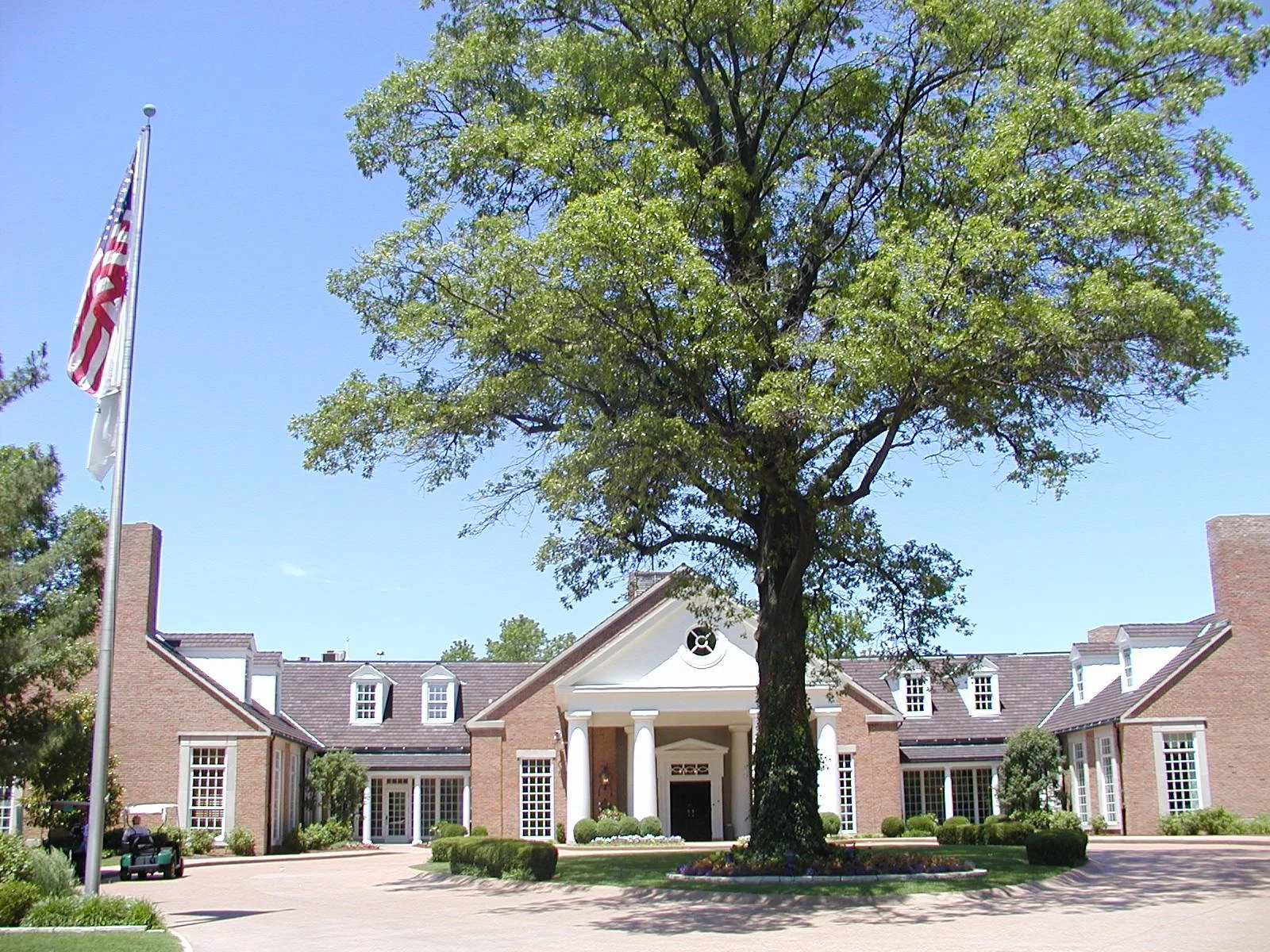GOLF COURSE REVIEW - BELLERIVE COUNTRY CLUB
Course Architect: Robert Trent Jones (late, 1950s), Rees Jones (2005-06, renovation), 2013
Year Opened: 1960
Location: St. Louis, Missouri
Slope: 141. Rating: 76.5
Par: 71
Yardage: 7,547
Hole-by-Hole: 1 - Par 4 438 Yds 10 - Par 4 519 Yds
2 - Par 4 413 Yds 11 - Par 4 376 Yds
3 - Par 3 194 Yds 12 - Par 4 482 Yds
4 - Par 5 575 Yds 13 - Par 3 184 Yds
5 - Par 4 473 Yds 14 - Par 4 415 Yds
6 - Par 3 215 Yds 15 - Par 4 494 Yds
7 - Par 4 397 Yds 16 - Par 3 237 Yds
8 - Par 5 618 Yds 17 - Par 5 608 Yds
9 - Par 4 445 Yds 18 - Par 4 464 Yds
Par 36 3,768 Yds Par 35 3,779 Yds
Key Events Held: U.S. Open (1965),
U.S. Mid-Amateur (1981),
PGA Championship (1992, 2018),
World Golf Championships (2001) - Not held due to 9/11,
U.S. Senior Open (2004),
BMW Championship (2008, 2026),
Senior PGA Championship (2013), Presidents Cup (2030).
Awards Won: Ranked #169 by Golf Digest of America's 200 Greatest Courses,
Ranked #2 by Golf Digest - Best course in Missouri (2023-26).
HISTORY: Although the course dates back to only 1960, Bellerive Country Club began in 1897 as a nine-hole venue with 166 members, known as St. Louis Field Club.
A baker's dozen years later, the membership incorporated the name Bellerive Country Club, named after Louis St. Ange De Bellerive, the last French commander in North America. Former USGA president and Masters chairman Hord Hardin along with Clark Gamble were the driving force to move the membership to a new site. Hardin, an 11-time club champion, brought in Robert
Trent Jones to design the new course, located west of Normandy, Missouri.
Jones found a pristine farm site and construction began on what would become the “Green Monster of Ladue.” . Just five years after the course opened in 1960, the USGA named Bellerive as the host of the U.S. Open, making it the youngest course ever to host the Open.
That year, Gary Player became the first foreigner to win the Open Championship since Ted Ray
in 1920. Tied after 72 holes with Kel Nagle with totals of two-over-par 282, Player built a five-stroke lead after eight holes of the playoff and went on to defeat Nagle by three, 71 to 74. Following his victory, Player donated his winnings to cancer research and junior golf. Player called his victory his
best day ever in golf, as he completed the career Grand Slam. The 1965 U.S. Open also marked the first time in 65 championships that the final round was conducted on Sunday and that it was televised in color.
The inaugural U.S. Mid-Amateur was first held at Bellerive in 1981, as St. Louis native Jim
Holtgrieve defeated Bob Lewis Jr, 2-up. Current Champions Tour player Jay Sigel was co-medalist that year, but lost in the quarterfinals.
Bellerive next hosted the PGA Championship in 1992, as Nick Price captured his first major. Two shots behind Gene Sauers heading into the final round, Price carded his fourth subpar round for a three-shot win over John Cook, Nick Faldo, Jim Gallagher Jr and Sauers. Price opened his round with nine straight pars, but seized the win with back-to-back birdies on 16 and 17. "I will always have a special place in my heart for Bellerive Country Club," said Price. "Your first major championship is always the most important. The fact that mine came at Bellerive, showed how much I enjoyed the golf course."
In 2001, Bellerive was set to host the World Golf Championships - the American Express Championship, but unfortunately the tragic circumstances of September 11th cancelled the event.
Let's not forget the 2004 U.S. Senior Open, as Peter Jacobsen, playing in only his third event with the over-50 circuit, captured his first major title, as he edge Hale Irwin by one shot. Trailing Tom Kite by one shot with just three holes remaining, Jacobsen parred all three while Kite bogeyed 16
and double-bogeyed 18, thus handing "Jake" the title. The final day, a 36-hole grind due to rain washing out play on Friday, proved to a supreme test for Jacobsen, as he had undergone hip surgery in late April and was on crutches for six weeks. Jacobsen, who shot four subpar rounds at Bellerive, became the second-youngest champion behind Dale Douglass and seventh first-time winner in his first Senior Open.
Following the Senior Open in 2005, Bellerive underwent a major restoration, as Rees Jones, came in to renovate his fathers design. Key changes to the course included a complete reconstruction of the bunkers, which was completed in 2013, lengthening and toughing the course and changes to holes 2, 7 and 8.
The BMW Championship was held in 2008, as Camilo Villegas recorded his first career title. The BMW will return to Bellerive in 2026.
After winning the U.S. Open in 2018, Brooks Koepka withstood a Tiger Woods rally to capture the 100th PGA Championship. Koepka, who became the fifth player to win both championships in the same year, carded a 4-under 66 for a two-shot win over Woods, who shot 64. Adam Scott finished alone in third, three shots back. Koepka, who carded four rounds in the 60s, shot the lowest score in event history at 264.
REVIEW: Bellerive starts out at first blush, a straight-away par four of 438 yards. But easy it's not, as the crowned fairway is difficult to hit and bunkers guard the left and right sides. Three-wood is the club of choice off the tee, as the fairway is quite narrow at the 150-yard mark. A middle iron
will be left to a green that is 30-yards deep, but very wide. Back left is the most difficult pin position, as two large bunkers play guardian. Jones termed this hole's scoring as "difficult pars, but comfortable bogeys."
Although fairly short, the second hole forces the player to be most accurate and long, as the hole doglegs sharply to the left. A tee shot of at least 270 yards is needed just to get past the corner of the lake. Bailing out right is no bargain either, as deep rough, as well as a large stand of tall trees. After a successful tee ball, a short iron is left to a 34-yard deep green with a large protecting bunker. A back-right pin is not one to fool with, not to mention a back-left stick, with water fronting the location. Play to the center of the green and walk away with par.
The first of four great par threes, the third is a beauty at 194 yards, increased over 30 yards. Water guards the entire right side of the huge green (42 yards). If the wind is up, this hole could be quite tricky and with a back pin, look out.
No question, the par-five fourth is a definite birdie chance. From an elevated tee overlooking the third, the hole swings down and to the left, with sand protecting both the left and right side of the fairway. A belt of 285-plus yards is needed to have any chance of going for the green in two. The smart play is a layup, some 75-100 yards from the hole. The elevated green is fairly small, but features a large swale in the center of the green and plenty of sand.
The fifth is a back-breaking, straight par four of 473 yards. A big tee shot is needed to leave a mid-to-long iron to an elevated, wide and narrow green. When Arnold Palmer played in the 1965 U.S. Open, he drove well right the first two days into a pond, making double-bogey and missing the cut for the first time in 91 tournaments. The putting surface is quite severe, especially if you're left and the pin is right. Two-putting with a 20-foot break would be quite miraculous.
It's been called one of the greatest par-3s in history. The sixth is quite difficult with water once again guarding the right side of the mammoth, 46- yard deep green. The hole can play from 170 yards to 215, and when the winds blow from the west, it's a short par-four. To make matters worse, a large sycamore tree guards the left side of the putting surface. The back-right pin is diabolical, just ask Bob Pansiuk. During the '65 Open, Panasiuk made a nine, despite reaching the green in regulation, as he putted off the green and into the water. That year, 82 balls were deposited into the pond.
Another possible birdie chance is the seventh. Just 397 yards, this short par-four is a slight dogleg left with a pair of bunkers guarding both sides of the fairway. A fairway metal or long iron will leave a wedge to a fairly accessible pin. The green is 36 yards deep and features a long hump in the center, so two-putting if on the wrong side could be quite difficult.
Accuracy reigns supreme on the eighth, the second-longest hole on the course. A tee shot to the right side of the fairway is needed to negotiate the dogleg left, or you will be blocked out of a quality layup shot. A creek rambles all along the right side of the fairway, ending within 100-yards of the green. Trees flank both sides of the corridor to the green. One bunker, 132 yards out protects the left side of the layup zone and a second, some 80-yards away, is located in the center of the fairway. The green is elevated and just 22 yards deep with two sunken bunkers, center and right. This hole is not a birdie hole, but a survival one. Take par and move on.
The last hole on the outward nine is an outstanding par four of 445 yards. Bending left and moving uphill, the ninth plays at least two clubs longer from the fairway to the elevated putting surface. Probably the most severe green on the course, the surface slopes from back-left to right-front and features three distinct putting zones. Bogeys will outnumber the pars.
The members like to play the 10th as a par five, which makes it quite easy. However, when playing from the championship tees, it's a par four of 519 yards and easily the hardest hole on the course. A mammoth tee shot is required on this dogleg left monster. The elevated tee box will help, but a missed fairway could result in bogey or worse. A small creek guards the bottom of the layup area, some 65 yards from the green. The putting surface is elevated and just 22 yards deep, but quite wide. Sand protects short and long and the putting surface will only receive perfectly struck shots. Making par here could be the highlight of your round.
Finally, a breather. The 11th is the shortest par four on the course, however, it's also the tightest. A long iron or fairway metal will leave a wedge to a very deep (46-yards) green, that is protected
short-right by a pond and a creek. The putting surface slopes severely from left to right and is very difficult to two-putt. Sometimes, short and easy is just the opposite.
Back to the braun of Bellerive, as play moves to the 12th. This dogleg left requires a big tee shot to the right side of the fairway. One of nine par fours over 400 yards in length, the 12th also features a very long green. When Nick Price captured the 1992 PGA Championship, he sank a 105-foot
birdie putt on this hole in his third-round 68. Sand guards both sides of the green, that slopes from back to front. Once again, par is a good score.
One of the prettiest holes on the course, the 13th showcases the blooming floral of Bellerive. Another long green on this par three makes club selection key. If the flag is front left, no problem. However when the pin is back-right, it could be a three-club difference. The putting surface is positioned diagonally from the tee with three distinctive swales throughout. As mentioned before, take par and move on.
The 14th hole marks the first of the five "ridge" holes that, except the 18th, usually play directly into the wind. A dogleg to the left, the tee shot must once again be placed on the right side of the fairway
to leave the best angle to the green. Possibly the easiest of the final holes, the tee shot is most demanding, due to thick rough and trees left and scattered oaks right. Your second shot into the green can range from a long iron to a wedge. The putting surface is only 30 yards deep, but is quite wide with three distinctive sections. This hole will set the tone for the remainder of the round.
If the 10th hole was not at Bellerive, than the 15th would be the most difficult. Grip it and rip it will be needed off the tee on this fairly straight, 494-yard par four. Into the wind, you will be left with a long iron or fairway metal to a very small target of just 24 yards in depth. Sand protects the landing area to the left of the fairway, while deep rough and trees will snare all shots right. Missing short of the green is no bargain either, as a deep valley is 30 yards short and two deep bunkers guard the left and right of the surface. Miss long and your left with a fast paced downhill pitch that could run back down the fairway. Making bogey is OK, just keep your cool.
The longest par three on the course, the 16th is a brute, especially with the wind howling in your face. A long iron or a fairway metal is required to reach the green. Short and you're sure to find one of the two deep bunkers protecting the green. Long and you'll be faced with a downhill putt or pitch
that runs 13-plus on the stimpmeter.
From the longest par three to the second longest par five, the 17th is a monster at 608 yards from the tips. A creek guards the entire right side of the hole along with trees, trees and more trees. Going
for this green in two is out of the question, unless your "Tin Cup." The creek protects the putting surface to the right and any ball landing short on the green, will most likely fall back into the water. To make matters worse, the green slopes from back to front, but this is really your last chance for a birdie.
The finishing hole requires a precise tee shot, as the hole doglegs to the left with two bunkers guarding the corner of the fairway. A chute of trees must first be negotiated off the tee. From the fairway, a mid to long iron awaits, despite playing downwind. The putting surface is well guarded up front with four large sand pits. The green slopes from right to left with the easiest pin spot, front and center. Missing this green will require some exacting work from your short game.
OVERALL: Bellerive is a classic course, rich in tradition.
From your drive into the course, the stately clubhouse and the magnificent grounds, you know
you're in for something special when playing here.
Bellerive reminds you of the outstanding Robert Trent Jones designs around the world, such as
Wilmington South in Delaware. Tall stately trees, large undulating greens and deep colorful bunkers. The course features many doglegs and possesses many water hazards, not to mention the length of the course. Here's a venue that has not grown old, but has matured into a venerable layout that has withstood the test of time.
The Rees Jones renovation has continued to the tradition of Bellerive and RTJ.
To coin a phrase, Bellerive has cache. The course is beautifully maintained and manicured to perfection, not a blade of grass out of place. The amenities and staff are also second to none. The bottom line, when in St. Louis, try at all costs to play this great classic.


